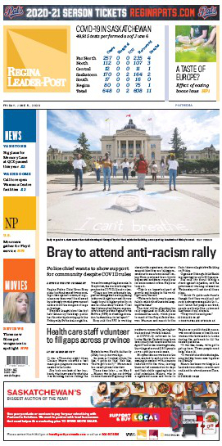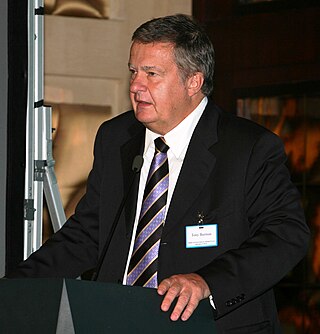
Caledon is a town in the Regional Municipality of Peel in the Greater Toronto Area of Ontario, Canada. The name comes from a shortened form of Caledonia, the Roman name for what is now Scotland. Caledon is primarily rural with a number of hamlets and small villages, but also contains the larger community of Bolton in its southeastern quadrant, adjacent to York Region. Some spillover urbanization also occurs in the south bordering the City of Brampton.

Vaughan is a city in Ontario, Canada. It is located in the Regional Municipality of York, just north of Toronto. Vaughan was the fastest-growing municipality in Canada between 1996 and 2006 with its population increasing by 80.2% during this time period and having nearly doubled in population since 1991. It is the fifth-largest city in the Greater Toronto Area, and the 17th-largest city in Canada.

The Globe and Mail is a Canadian newspaper printed in five cities in western and central Canada. With a weekly readership of more than 6 million in 2024, it is Canada's most widely read newspaper on weekdays and Saturdays, although it falls slightly behind the Toronto Star in overall weekly circulation because the Star publishes a Sunday edition, whereas the Globe does not. The Globe and Mail is regarded by some as Canada's "newspaper of record".

William Lyon Mackenzie was a Scottish Canadian-American journalist and politician. He founded newspapers critical of the Family Compact, a term used to identify elite members of Upper Canada. He represented York County in the Legislative Assembly of Upper Canada and aligned with Reformers. He led the rebels in the Upper Canada Rebellion; after its defeat, he unsuccessfully rallied American support for an invasion of Upper Canada as part of the Patriot War. Although popular for criticising government officials, he failed to implement most of his policy objectives. He is one of the most recognizable Reformers of the early 19th century.

The Kainai Nation is a First Nations band government in southern Alberta, Canada, with a population of 12,965 members in 2024, up from 11,791 in December 2013.

The Regina Leader-Post is the daily newspaper of Regina, Saskatchewan, Canada, and a member of the Postmedia Network.
Black Press Group Ltd. (BPG) is a Canadian commercial printer and newspaper publisher founded in 1975 by David Holmes Black, who has no relation to Canadian-born media mogul Conrad Black. Based in Surrey, British Columbia, it was previously owned by the publisher of Toronto Star and Black (80.65%).

Canadian Business is the longest-publishing business magazine based in Toronto, Ontario, Canada, and founded in 1927. The print edition terminated in the end of 2016. Beginning in January 2017, the magazine was published online only.

The Bank of the People was created by radical Reform politicians James Lesslie, James Hervey Price, and Dr John Rolph in Toronto in 1835. It was founded after they failed to establish a "Provincial Loan Office" in which farmers could borrow small sums guaranteed by their land holdings. The Bank of the People was the only bank in Upper Canada not to suspend payments during the financial panic of 1837-8. Many of the shareholders, however, took part in the Rebellion of 1837 and the Family Compact plotted to have it taken over by the Bank of Montreal in 1840.
The Varsity is the official student newspaper of the University of Toronto, in publication since 1880. Originally a broadsheet daily, it is now printed in compact form. The paper's primary focus is on campus affairs and local news.

The StarPhoenix is a daily newspaper that serves Saskatoon, Saskatchewan, Canada, and is a part of Postmedia Network. It has been referred to as a "sister newspaper" to the Leader-Post. The StarPhoenix puts out six editions each week and publishes one weekly, Bridges. It is also part of the canada.com web portal.

Tony Burman is a Canadian broadcaster, journalist and university official. Starting in the 1960s, Burman has worked as a journalist, in print, radio, television, and online. For most of this time, he was at the Canadian Broadcasting Corporation. Later he joined Al Jazeera English. He is also active in supporting public broadcasting and investigative journalism.

James Beaty was a Member of Canada's Parliament from 1867 to 1874, and published the Toronto Leader newspaper.

The 1969 White Paper was a policy paper proposal set forth by the Government of Canada related to First Nations. Prime Minister Pierre Trudeau and his Minister of Indian Affairs, Jean Chrétien, issued the paper in 1969. The White Paper proposed to abolish all legal documents that had previously existed, including the Indian Act, and all existing treaties within Canada, comprising Canadian Aboriginal law. It proposed to assimilate First Nations as an ethnic group equal to other Canadian citizens. The White Paper was met with widespread criticism and activism, causing the proposal to be officially withdrawn in 1970.
The Siuslaw News is a weekly newspaper published in Florence, Oregon, United States, since 1904. The News covers western Lane County, from the Pacific Ocean to Deadwood and Greenleaf, and from Yachats on the north to Gardiner on the south. It is published on Wednesdays and has a circulation of 4,000. The paper was published weekly until 2000, when its frequency was increased to twice-weekly, and returned to weekly publication in July 2022.

There were five important periods in the history of Canadian newspapers' responsible for the eventual development of the modern newspaper. These are the "Transplant Period" from 1750 to 1800, when printing and newspapers initially came to Canada as publications of government news and proclamations; followed by the "Partisan Period from 1800–1850," when individual printers and editors played a growing role in politics. The "Nation Building Period from 1850–1900," when Canadian editors began the work of establishing a common nationalistic view of Canadian society. The "Modern period" from 1900 to 1980s saw the professionalization of the industry and the growth of chains. "Current history" since the 1990s saw outside interests take over the chains, as they faced new competition from the Internet.

Canadian comics refers to comics and cartooning by citizens of Canada or permanent residents of Canada regardless of residence. Canada has two official languages, and distinct comics cultures have developed in English and French Canada. The English tends to follow American trends, and the French, Franco-Belgian ones, with little crossover between the two cultures. Canadian comics run the gamut of comics forms, including editorial cartooning, comic strips, comic books, graphic novels, and webcomics, and are published in newspapers, magazines, books, and online. They have received attention in international comics communities and have received support from the federal and provincial governments, including grants from the Canada Council for the Arts. There are comics publishers throughout the country, as well as large small press, self-publishing, and minicomics communities.

Leader's Lane is a short street in Toronto, Ontario, Canada. The street was part of the former city of York, Upper Canada. It runs from Wellington Street to King Street, crossing Colborne Street. The street was renamed Leader's Lane after the Toronto Leader, a newspaper whose offices were located there from 1852 to 1878.
Québécois are people associated with Quebec. The term is most often used in reference to either descendants of the French settlers in Quebec or people of any ethnicity who live and trace their origins in the province of Quebec.
Charles Lindsey was an English-born Canadian journalist, editor, writer, and officeholder. He was the first editor of the Toronto Leader and published a biography on his father-in-law William Lyon Mackenzie, The Life and Times of Wm. Lyon Mackenzie (1862).













